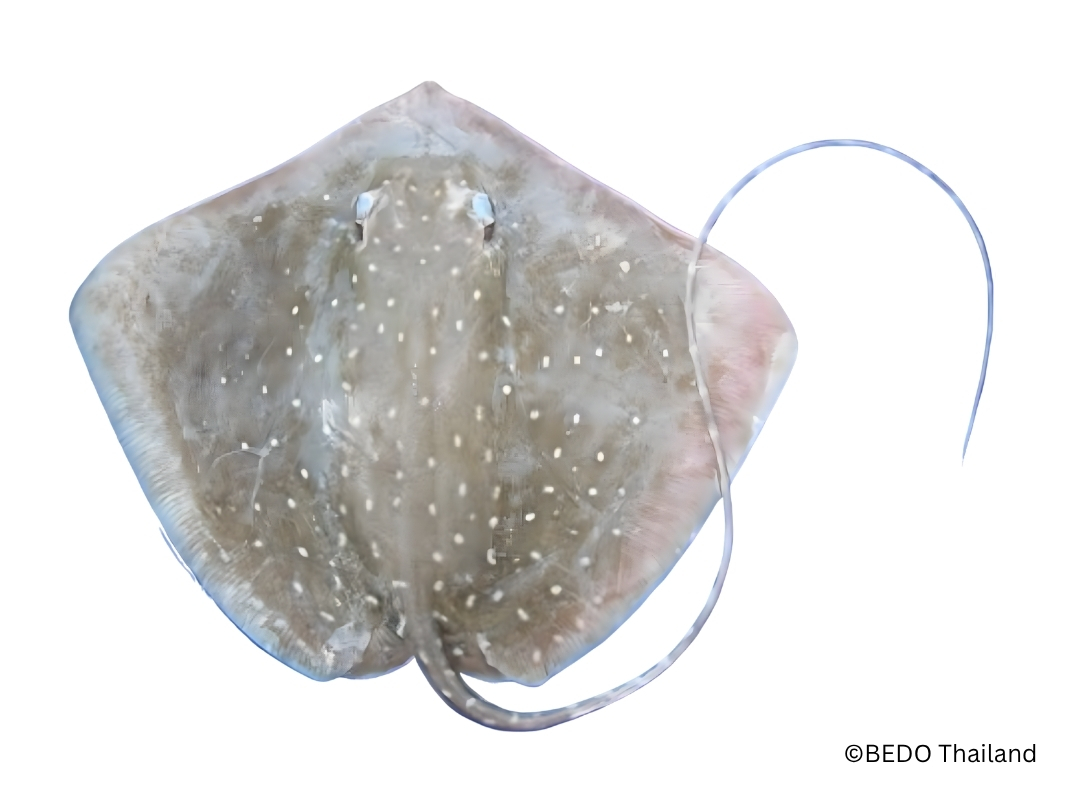Species Name
Whitespotted Whipray
Scientific Name
Maculabatis gerrardi
Family Name
Dasyatidae
IUCN Status
Endangered
A whipray of considerable size characterized by a rhomboidal-shaped disc with narrowly rounded tips. The snout is broadly triangular, culminating in a small tip. The tail is exceptionally slender, elongated, and whip-like beyond the sting, lacking cutaneous folds. The disc's surface typically exhibits a paler greenish-grey or greyish-brown hue with numerous white spots towards the rear, although in some cases, it may be plain. Additionally, the tail is banded beyond the sting.
Biology
Length: Males achieve a maximum size of 116 cm disc width (DW), females reach a maximum size of 63 cm DW, while the size at birth ranges from 13 to 21 cm DW.
Gestation period: Unknown
Littter size: Reproduction is viviparous with litter sizes of 2–4 pups
Life Expectancy: According to Jacobsen and Bennett (2010), female Blackspotted Whipray have a maximum age of 29 years, an age-at-maturity of nine years, and a generation length of 19 years. The generation duration was adjusted to 25 years because the Blackspotted Whipray has a lesser maximum size (80 cm DW) than the Whitespotted Whipray (116 cm DW).
Diet: Feeds on bottom crustaceans including shrimp, crabs and small lobsters
Habitat and Distribution
Habitat: The Whitespotted Whipray occurs inshore on soft substrates down to depths of at least 60 m.
Distribution: The Indo-Pacific region is home to the Whitespotted Whipray, which ranges from the Arabian/Persian Gulf to Taiwan and includes Indonesia and the Southeast Philippines.
Known landing centres: Royapuram Fishing Harbour, Cuddalore Fishing Harbour, Nagapattinam Fishing Harbour, Junglighat, Burmanallah, Wandoor, Dignabad, Malvan, Cochin Fisheries Harbour, Machilipatnam, Nizampatnam, Vodarevu, Pakala, Malvan, Veraval, Mangrol, Porbander and Okha.
Depth: 0-60 m
Commercial Value
The individuals landed as bycatch are sold in the local market for consumption
Threats
Intense fishing pressure, caught as bycatch using inshore fishing gear (beach seine, gillnet, purse seine, benthic longline, trawl etc).
References
- Last, P.R., W.T. White, M.R. de Carvalho, B. Séret, M.F.W. Stehmann and G.J.P. Naylor, 2016. Rays of the world. CSIRO Publishing, Comstock Publishing Associates. i-ix + 1-790. (Ref. 114953)


Related Species
- Jenkins Whipray
- Cowtail Ray
- Coach Whipray
- Scaly Whipray
- Arabian Banded Whipray
- Bengal Whipray
- Bennett's Stingray
- Blackedge Whipray
- Bleeker’s Whipray
- Blotched Fantail Ray
- Bluespotted Lagoon Ray
- Bluespotted Maskray
- Broad Cowtail Ray
- Brown Stingray
- Giant Freshwater Whipray
- Honeycomb Whipray
- Indian Sharpnose Ray
- Kuhl's Maskray
- Leopard Whipray
- Mangrove Whipray
- Narrow Cowtail Ray
- Pakistan Whipray
- Pale-edge Sharpnose Ray
- Pelagic Stingray
- Pink Whipray
- Porcupine Ray
- Roughtail Stingray
- Round Whipray
- Shorttail Whipray
- Smalleye Stingray

